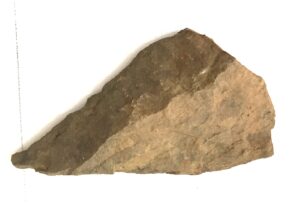Art Adventure • 7.04.2023 • Yellow Ochre
Much to my amazement, when I searched “ochre Massachusetts,” Google gave me a useful result, an abandoned “paint mine” active in the 1860s, where a natural deposit of ochre had yielded a yellow-brown pigment “of superior quality.”
This very specific information was a great help to a neophyte pigment hunter who could reliably identify only granite, slate and quartz. Not only was the mine said to be “still visible,” but Mindat.org had the coordinates.

So far, so good. But how to use longitude and latitude to identify a particular place? It turns out that Google Maps, once you learn the correct format in which to state the coordinates, can provide directions.
Now I had a location, a couple of photographs of the mine, and a picture of yellow ochre in the raw. My friend Wendy Drexler, a poet who used one of my paintings as the cover illustration for her book Before There Was Before, and I set off in my car with the GPS cranking. I had a backpack filled with the modern woman’s prospecting kit: a claw hammer, a large soup spoon, and several Tupperware containers. Forgot the water. And the bug spray. Fortunately Wendy remembered both.
The mine was several hundred yards from the road and it was challenging to figure out where to park until we found a trailhead. Then we set off on the wrong side of the road along a right-of-way for a high-voltage transmission line. We found a wooly spider carrying her babies on her back and various rocks we could not identify, but nothing that looked like our photo of the mine, much less any ochre.
GPS is not great where there are no roads, but eventually we figured out our mistake, went back to the car, crossed the road to the other trailhead and set off again, only to find, after wandering around in people’s yards, a meadow, and the edge of a forest, that we had been right in the first place, and across to the other trailhead we went, begging the question, Why did the novice rock hounds…
Eventually, with the help of a sign saying “paint mine” pointing in a somewhat indeterminate direction, we located the spot, although it did not look like a mine (so much for “still visible”). The only reason we found the deposit is that yellow ochre rocks were trapped in the roots of a fallen tree. Once we knew what it looked like, it was easy to find other specimens on the ground. I collected a chunk!
I was ecstatic. I had not been certain that my pigment project was actually doable, that I would be able to locate and identify any sources of pigment in New England. And here on our first try we had a significant piece of yellow ochre!
To say yellow ochre is yellow is pretty much to miss the point. Its major component is limonite, a combination of various iron hydroxides, mainly goethite. Depending on its exact composition, limonite varies in hue from light yellow to brownish yellow. Paint manufacturers distinguish among these colors and generally offer several different shades. Winsor & Newton Artists’ Oil Colours are available in yellow ochre pale yellow ochre light, gold ochre, yellow ochre, raw sienna, burnt sienna and transparent gold ochre. Natural Pigments offers more than a dozen powdered yellow ochre pigments from the BlueRidge Mountains, Armenia, France, and Italy. They range in color from the faintest tinge of yellow to distinctly brown.
Geothite changes to hematite (from yellow to red) at about 300 degreesCentigrade, which is why burnt sienna, even though it is distinctly reddish, is included among the yellow ochres. Correcting my earlier statement about ochres at The Harvard Museum of Natural History, I note that the museum does have examples of limonite, geothite, and hematite labeled as such; I did not realize those were actually the ochres I was looking for.
A challenge for another day is to figure out if putting yellow ochre in a kitchen oven and turning up the heat to 500 degrees Fahrenheit will turn yellow ochre into hematite without burning down the building. I’ll let you know.